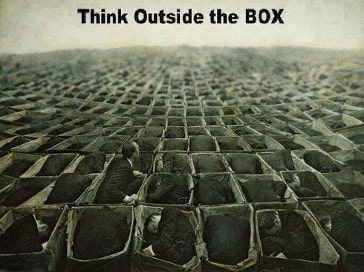
Neuroplasticity versus Insanity
Stepping outside the BOX
Headbanging: Doing the same things over and over, expecting different results
Peering over the top of the “sameness box” is the first step: you cannot expand your horizons inside a box
Perhaps the hardest lesson for a successful strength trainer to learn is what to do when a favored strength training program has run out of productivity and the time has come to replace this favored mode or method with a new method of training that dramatically contrasts whatever has been and is being done.
There is no such thing as a single magical method that once found becomes an eternal wellspring of physique improvement and performance progress. Every training routine, every drill, has a shelf life, a finite period wherein gains are forthcoming.
The body, with its innate wisdom, eventually figures out how to neutralize what was once shocking and extreme. The body seeks hemostasis, normalcy. Gains do not spring from hemostatic normalcy. Gains arise from self-inflicted trauma. Effective training upsets hemostatic normalcy. When the training dose that was once groundbreaking and traumatic losses its stressor status, it devolves into “more of the same” and progress grinds to a halt.
Multi-time IPF world champion and world record holder Kirk Karwoski and I strength train regular men and boys, dudes from the neighborhood, every Sunday from 9 am to 11 am at Donny “Bubbles” Berry’s country barn at the foot of the Catoctin Mountains in Maryland. We have been doing so for a decade. It is interesting to see how our regulars deal with the inevitable plateau that inevitably occurs using our (or any) ultra-minimalistic format.
One of our core members has had a progress trajectory that showed steady improvement for over four years. That’s no typo, this dude went from pitiable, to normal, and then he kept on going. He was coming from a damaged place, an injured Marine. He went from standing in a deep hole to normalization then onto outstanding before morphing into extraordinary – then he hit the wall – and has been bashing his head against the “sameness wall” for the last six months.
This 42-year-old husband and father of three had not done any serious barbell training before falling into our orbit: he was a blank canvas; he literally knows no other way to train. He has an introverted and stoic personality. Dependable, he is not adventurous or receptive to new exercises or ideas. But he can grind, and adhere, and push through pain and discomfort. He is methodical – but not a student of training. In an interesting personality tell, during his stagnant period, he became a certified powerlifting judge – not a coach. Some types are drawn to judging, others to coaching.
His personality is that of the watcher. He never misses a workout and always gives 100%. Unfortunately, for the last six months it’s been the same 100%. He steps up to do the Big Three but never steps up to try new exercises or techniques. If called upon, he steps up without hesitation, but I have never seen him say, “Let me try that!” or “Check this out!” He sticks to the three lifts. He began doing overhead presses after I pestered him.
The challenge for many trainees is a lack of training breadth. They only have one way of training, and they train that way all the time. If they are lucky, they initially find a result-producing program. If shown how, diligent people will execute training strategies with the requisite intensities.
When minimalistic resistance training stalls, the usual remedy is to throw in a nutritional angle; start consuming copious calories, push bodyweight upward, lift heavy weights, eat big, do so systematically and gains can last for years. When the first serious strength training plateau is encountered, the favored stagnation breaker is to “eat your way through sticking point,” as my iron mentor, Hugh “Huge” Cassidy advised.
Hugh Cassidy knew of what he spoke: he pushed his bodyweight, sumo wrestler-like, from a lean and athletic 195-pounds to a gargantuan 295-pounds. Cassidy used forced eating and power training to raw squat and deadlift 800-pounds, wearing not even a weightlifting belt. He bench-pressed 570-pounds, raw, this with a 2-second pause on the chest.
Hugh force-fed; he ate his way upward with systematic methodical-ness. For four years, everywhere he went he carried a beach cooler filled with sandwiches, fruit, pie or cake slices, a half-gallon of milk (which he replenished throughout the day) rice, baked potatoes, BBQ chicken wrapped in tinfoil. Hugh “grazed” from dawn to bedtime. Then he got up in the middle of the night to drink a quart of whole milk.
The Cassidy method resonated with power trainers. Diligent trainees pushed their bodyweight upward, staying in caloric surplus, each successive week, slightly heavier, slightly stronger. As the powerlifter pushes his bodyweight upward, he sets personal records and creates muscle. He eats his way through sticking points.
Still, at some juncture, all the possible gains will have been squeezed from the power training/heavy eating approach. The contents and combinations of this particular box will have been exhausted. How do you step outside the box when the interior of the box is all you know? At some point, the trainee hits the wall, regardless the approach. It is inevitable.
Those that power train and eat their way through sticking points will either 1.) add an unacceptable amount of body fat, or 2.) Discover that there are only so many sticking points you can eat your way through, using a lone and unvarying resistance training strategy.
Our man hit the wall: he stands 6-foot and weighs a muscled-up 200-pounds. He raw squats 350, bench presses 275, and deadlifts 440. He squats, benches and deadlifts once a week. Here is the inconvenient truth staring him in the face: at age 42, standing 6-foot and weighing 200-pounds, he has gone about as far as he can, doing what he is currently doing. The best he can hope for is perhaps some slight improvements due to technical improvement, otherwise the best he can hope for is to maintain the physique and capacities has built to this point.
Week in week out, for the last six months, he has shown up every Sunday and pounded his head against the sameness wall. Revisiting lesser poundage and being unable to improve on past personal bests. He (deservedly) likes the way he looks at 200-pounds and has no burning inclination to push his bodyweight up to 215 or 220-pounds. Conversely, he doesn’t burn to drop 15-pounds and get ripped. He has no burning dissatisfactions, and this is psychologically problematic: essentially, he is training to stay the same.
Intense dissatisfaction is a mental condition that turns thought into action. When we are truly disgusted with ourselves, or when we are truly fired up in pursuit of a new physiological goal (“I want to get ripped for the class reunion in three months” or “I want to build an honest 17-inch arm.”) we get things done. We push ourselves to new levels of performance and in doing so grow muscle.
In dissatisfactions absence, complacency takes root. The opposite of dissatisfaction is satisfaction: nothing of any physiological consequence ever arises out of satisfaction.
Goal attainment is rooted in intense dissatisfaction - with our current state, our physical condition. The solution is to find motivating goals and then select proven-effective methods. Step outside the box, seek strategies that sufficiently contrast with current stale, overused modes and methods. Creating motivating goals and identifying and adopting contrasting methods (to those being currently practiced) is the eternal solution to overcoming physical stagnation.
When mired in stagnation, creating contrast is the key to igniting progress where none exists. Doing the same things, over and over, and expecting different results, is a deserved cliché and an unproductive dead-end. How much head-banging can a trainee absorb before they quit?
Avoid flogging the body: don’t insist on the impossible, i.e., that the body can radically and dramatically transform in response to repeated sameness. When confined in a tight box, the wrong solution to overcoming stagnation is to increase the volume and intensity of the sameness.
- The velvet rut: Austin Texas has such a vibrant club scene that an elite local musician can make an excellent living playing clubs, “a velvet rut that kills creativity.” In resistance training, the velvet rut is using a familiar way of training, a workout strategy proven effective, continuing to use a favored training strategy long after results have ceased. At best, you are maintaining what you have.
- Scientist or Fundamentalist? Do not turn a mode, method, guru, or strategy, into a religion. The fundamentalist defends an entrenched position and rejects any information or data that contradicts or questions the fundamentalist dogma. A scientist embraces change and evolution. The strength training fundamentalist stays within the box and rejects the idea that progress lies outside the box.
- Frozen and fossilized is no way to go through life son: paraphrasing Dean Wormer in Animal House, an inability to change is fatal. Be openminded, fluid, seek out and examine new ideas. Over time, the diligent trainee assembles a collection of contrasting methods that can knowingly be called upon to unlock a stagnation logjam.
- Contrast is uncomfortable: Aristotle once noted, We are what we do repeatedly. To be more than what we are, we have to change what we do. How do we define change? Real change is 180-degrees opposite of whatever you have been doing. Anything less than a complete opposite dilutes potential results. Slight changes create, at best, slight improvement.
- Stepping all the way out of the sameness box: empirical experience has shown that there are four disparate disciplines that need be included and executed in a balanced and periodized fashion; resistance training, nutrition, cardiovascular training, and the psychological aspects related to the transformational process. Three of the four disparate disciplines lie outside the strength training box.
- Subtle and nuanced: over time, the sophisticated trainee develops an arsenal of proven-effective, dramatically contrasting strategies within each of the four interrelated disciplines. Strength training can pendulum swing between volume and intensity; cardio contrast can juxtapose interval cardio with steady-state cardio. Nutritional contrast can alternate between calorie surplus and caloric deficit.
The seasoned pro cultivates contrasting methods, uses them in skillful juxtaposition to generate measurable physical progress. The only constant in transformative fitness is inertia, stagnation, torpor. Every artist and athlete must (eventually) step outside the box of the known in order the improve their art, physique, or performance. The first step to overcoming inertia is recognizing it. Once identified, burning dissatisfaction and goal setting are in order. If the dissatisfaction is strong enough, action is easy.
About the Author - Marty Gallagher
As an athlete Marty Gallagher is a national and world champion in Olympic lifting and powerlifting. He was a world champion team coach in 1991 and coached Black's Gym to five national team titles. He's also coached some of the strongest men on the planet including Kirk Karwoski when he completed his world record 1,003 lb. squat. Today he teaches the US Secret Service and Tier 1 Spec Ops on how to maximize their strength in minimal time. As a writer since 1978 he’s written for Powerlifting USA, Milo, Flex Magazine, Muscle & Fitness, Prime Fitness, Washington Post, Dragon Door and now IRON COMPANY. He’s also the author of multiple books including Purposeful Primitive, Strong Medicine, Ed Coan’s book “Coan, The Man, the Myth, the Method" and numerous others. Read the Marty Gallagher Biography for a more in depth look at his credentials as an athlete, coach and writer.



